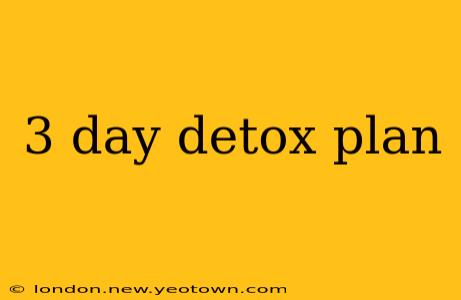Jumpstart Your Health: A 3-Day Detox Plan for a Fresher You
Let's be honest, life gets hectic. Between work deadlines, family commitments, and social events, nourishing our bodies often takes a backseat. We crave that feeling of lightness, that burst of energy, and that clearer complexion, and sometimes, a short detox can be just the ticket to reset and revitalize. This isn't about extreme deprivation; instead, it's a gentle nudge toward healthier habits, a springboard to a more vibrant you. This 3-day detox plan focuses on nourishing whole foods, gentle cleansing, and mindful hydration – a manageable approach that fits into a busy schedule.
Important Note: This plan is a general guideline. Before starting any detox, especially if you have underlying health conditions, consult your doctor or a registered dietitian. This is not a substitute for medical advice.
What is a Detox? (And is it Really Necessary?)
Many believe detoxing involves ridding the body of harmful toxins. While our liver and kidneys naturally perform this function, a short-term detox can help support these organs by focusing on nutrient-rich foods that promote healthy elimination. This 3-day plan aims to gently cleanse, improve digestion, and boost energy levels, not to drastically alter your body's natural processes. Think of it as a mini-reset, a chance to give your body a break from processed foods and refined sugars.
What to Expect During the 3-Day Detox
Expect to feel increased energy, improved digestion, and potentially clearer skin. You might also experience some mild detoxification symptoms, such as headaches or fatigue in the initial phase, but these are usually temporary. Staying hydrated is crucial during this period to help flush out toxins effectively.
Day 1: Focusing on Hydration and Fiber
Breakfast: A large bowl of oatmeal with berries and a sprinkle of nuts. Oatmeal provides soluble fiber, promoting healthy digestion, while berries are rich in antioxidants.
Lunch: A large salad with leafy greens, grilled chicken or fish, and a light vinaigrette dressing. Leafy greens offer essential vitamins and minerals.
Dinner: Lentil soup with a side of whole-wheat bread. Lentils are packed with fiber, aiding in digestive regularity.
Snacks: Fruits like apples or bananas, a small handful of almonds, or a cup of herbal tea.
Hydration: Aim for at least 8 glasses of water throughout the day. You can also include herbal teas like ginger or chamomile.
Day 2: Boosting Liver Function and Reducing Inflammation
Breakfast: Smoothie made with spinach, banana, almond milk, and a scoop of protein powder. Spinach aids in liver detoxification.
Lunch: Baked salmon with roasted vegetables (broccoli, carrots, sweet potatoes). Salmon is rich in omega-3 fatty acids, which have anti-inflammatory properties.
Dinner: Chicken stir-fry with brown rice and plenty of colorful vegetables. The variety of vegetables provides a wide range of vitamins and minerals.
Snacks: A small portion of Greek yogurt, a handful of berries, or vegetable sticks with hummus.
Hydration: Continue with at least 8 glasses of water, and consider adding a slice of lemon to your water for an extra boost.
Day 3: Restoring Gut Health and Reintroducing Healthy Fats
Breakfast: Chia seed pudding with berries and a drizzle of honey. Chia seeds are an excellent source of fiber and omega-3 fatty acids.
Lunch: Quinoa salad with avocado, black beans, and corn. This salad provides healthy fats and fiber.
Dinner: Turkey meatballs with zucchini noodles. Zucchini noodles are a low-carb alternative to pasta.
Snacks: Avocado toast (whole-wheat bread), a small handful of trail mix, or a piece of fruit.
Hydration: Maintain your daily water intake and consider adding cucumber or mint to your water for a refreshing twist.
What Foods to Avoid During the Detox
During this 3-day plan, minimize or avoid:
- Processed foods: These are often high in unhealthy fats, sodium, and additives.
- Refined sugars: These can contribute to inflammation and energy crashes.
- Caffeinated beverages: These can dehydrate you and interfere with sleep.
- Alcohol: This can put extra strain on your liver.
How to Make the Detox Sustainable
The key to long-term health isn't a quick fix; it's about building sustainable habits. After completing the 3-day detox, gradually reintroduce foods that you may have avoided, paying attention to how your body reacts. Consider incorporating more whole foods, fruits, and vegetables into your regular diet. Prioritize hydration and regular exercise for lasting well-being.
Frequently Asked Questions
H2: How long does it take to see results from a 3-day detox?
You might notice improved energy levels and clearer skin within a few days. However, remember that this is a short-term plan, and the most significant long-term benefits come from adopting a healthy lifestyle consistently.
H2: What are the side effects of a 3-day detox?
Some people might experience mild side effects such as headaches, fatigue, or digestive upset, particularly during the first day. These are usually temporary. Staying hydrated and listening to your body are essential.
H2: Can I do a 3-day detox more than once a year?
You could, but it's not necessary. Focus on maintaining a healthy lifestyle throughout the year. This short detox is more of a reset or a jumpstart rather than a regular practice. A healthy lifestyle that includes a balanced diet and regular exercise is far more effective.
H2: Is a 3-day detox effective for weight loss?
While you may see a temporary weight loss due to fluid loss, a 3-day detox is not a sustainable weight loss strategy. Long-term weight management requires a holistic approach with balanced nutrition and exercise.
By following this plan and making conscious dietary choices, you can give your body the support it needs to thrive. Remember to listen to your body, and if you experience any concerning symptoms, stop the detox and seek professional medical advice. Enjoy the journey to a healthier, happier you!

